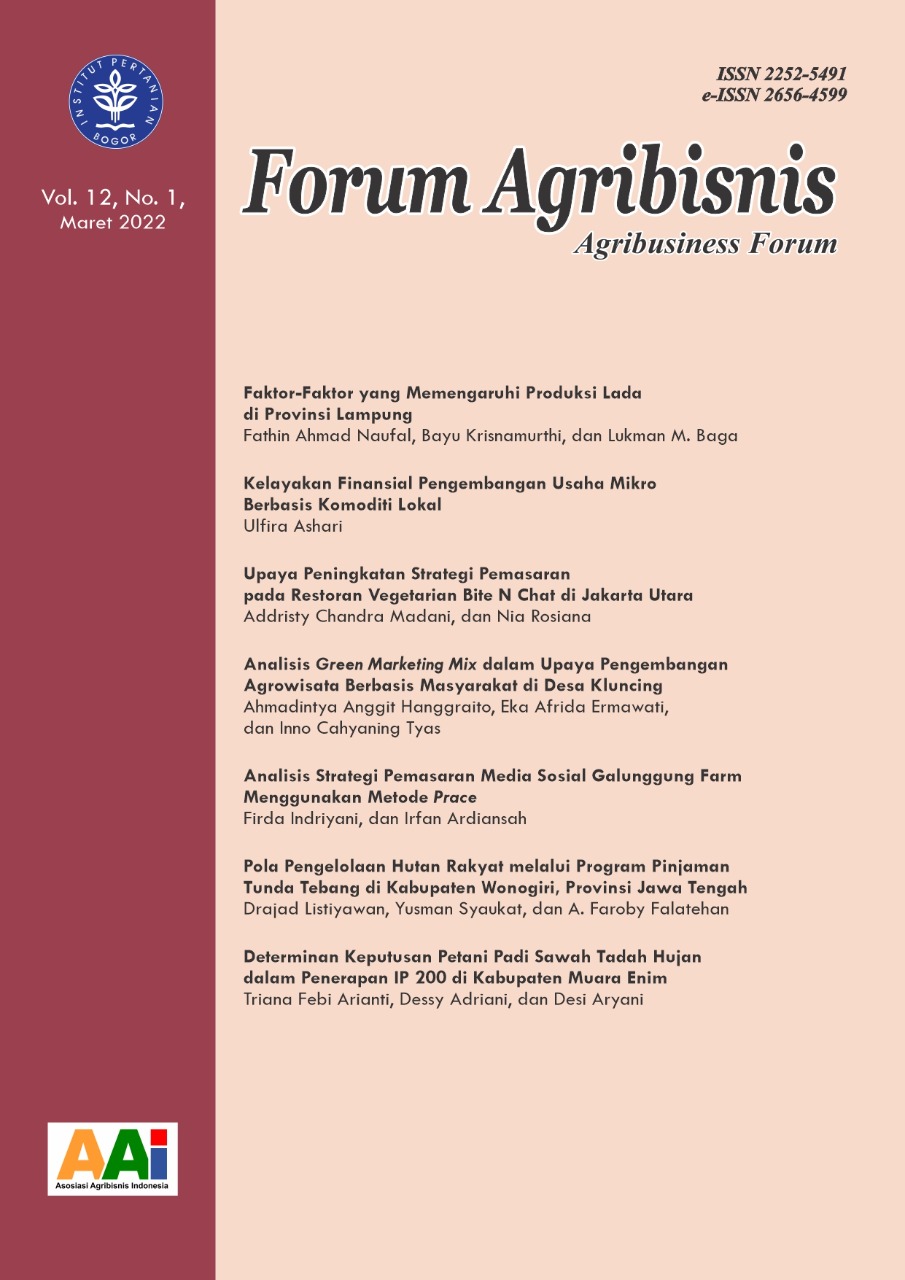Analisis Strategi Pemasaran Media Sosial Galunggung Farm Menggunakan Metode Prace
Main Article Content
Abstract
Digital marketing is very important because of the advancement of industry in the world, making many companies use digital marketing in promotion and sales so that the use of digital media increases. This makes Galunggung Farm want to develop sales by developing new markets by focusing on market development towards B2C (Business to Customer), therefore Galunggung Farm utilizes digital marketing for new situations and strategies. The digital media used for digital marketing is Instagram. This study aims to determine the current state of Galunggung Farm's digital marketing based on the analysis of the PRACE framework (Plan, Reach, Act, Convert, and Engage) and produce goals and KPIs (Key Performance Indicators) of Galunggung Farm's digital marketing based on the results of the initial analysis. The method used is PRACE (Plan, Reach, Act, Convert, and Engage). The results of the analysis show that in the current social media marketing of Galunggung Farm, several things can be improved. Based on this, the company's objectives are stated, namely: 1) Build brand awareness and follower conversion, 2) Initiate brand interaction, 3) Achieve sales conversion, 4) Reach fans and initiate brand engagement, resulting in KPI (Key Performance Indicator) for social media Instagram Galunggung Farm are 1) Reach (Reach and followers), 2) Act (likes and comments), 3) Convert (content saved and conversation rate), 4) Engage (content shared, online reviews, users testimonials, and recommendations).
Downloads
Article Details

This work is licensed under a Creative Commons Attribution-ShareAlike 4.0 International License.
The author submitting the manuscript must understand and agree that the copyright of the article manuscript must be submitted/transferred to the Journal Forum Agribisnis. This work is licensed under the Creative Commons Attribution-ShareAlike 4.0 (CC BY-SA) International License in which the Author and Reader can copy and redistribute the material in any media or format, and remix, modify and build material for any purpose, but they must provide appropriate credit (citing articles or content), provide a link to the license, and indicate whether there is a change. If you mix, change, or create material, you must distribute your contribution under the same license as the original.
References
Bagus Pratama, N., Dewi, K., & Baroto, T. (2015). Analisis Persaingan Dan Kepuasan Konsumen Dengan Menggunakan Metode Correspondance Analysis Dan Importance Performance Analysis. Jurnal Teknik Industri, 16(2), 74–82.
Chaffey, D., & Smith, P. (2017). Digital Marketing Excellence.
Dabbous, A., & Barakat, K. A. (2020). Bridging the online offline gap: Assessing the impact of brands’ social network content quality on brand awareness and purchase intention. Journal of Retailing and Consumer Services, 53(November 2018), 101966. https://doi.org/10.1016/j.jretconser.2019.101966
Ellis, N. (2011). Business-to-business marketing : relationships, networks and strategies. Oxford : Oxford University Press.
Karki, S. (2020). Digital Marketing in Nepal. LAB University of Applied Sciences.
Kotler, P., Armstrong, G., & Opresnik, M. O. (2017). Principles of marketing. Pearson. https://books.google.co.id/books?id=W29mswEACAAJ
Kotler, P., & Keller, K. (2009). Manajemen Pemasaran (13th ed.). Penerbit Erlangga.
Maharani, A., Ardiansah, I., & Pujianto, T. (2019). Efektivitas Penggunaan Instagram melalui Dua Tahap Analisis pada Zanana dan Oifyoo. Jurnal Rekayasa Sistem Industri, 8(1), 47–54. https://doi.org/10.26593/jrsi.v8i1.3216.47-54
Mayasari, I., Haryanti, K., & Hindiarto, F. (2012). Penilaian Kinerja Berdasarkan Kompetensi dan KPI (Key Performer Indicator) Perusahaan Daerah Air Minum Kabupaten Semarang. Prediksi , Kajian Ilmiah Psikologi, 1.
Michalski, J. (2019, September 9). Instagram Study 2019: What we learned analyzing 5.4 million posts. https://www.quintly.com/blog/instagram-study-2019
Mulyadi, M. (2011). Penelitian Kuantitatif Dan Kualitatif Serta Pemikiran Dasar Menggabungkannya [Quantitative and Qualitative Research and Basic Rationale to Combine Them]. Jurnal Studi Komunikasi Dan Media, 15(1), 128.
Pradhan, P., Nigam, D., & Tiwari, C. K. (2018). Digital marketing and SMEs: an identification of research gap via archives of past research. International Journal of Applied Engineering Research, 13(8), 6089–6097.
Rajesham, C. H., & Singh, B. J. (2019). Race : An effective CRM model for digital marketing. 45–48.
Saha, S. K., Islam, A., & Rodela, R. S. (2014). A Comparative Study On B2B Vs. B2C Based On Asia Pacific Region. International Journal of Scientific & Technology Research, 3(9), 294–298.
SEA Insights. (2020). Pandemi Covid-19 Pacu UMKM Gunakan Media Digital. 1.
Shabbir, M. Q., Khan, A. A., & Khan, S. R. (2017). Brand Loyalty Brand Image and Brand Equity: the Mediating Role of Brand Awareness. International Journal of Innovation and Applied Studies, 19(2), 416–423.
Sugiyono, P. D. (2017). Metode Penelitian Bisnis: Pendekatan Kuantitatif, Kualitatif, Kombinasi, dan R&D. Penerbit CV. Alfabeta: Bandung.
Verawati, N. (2016). Pergeseran Pemanfaatan Instagram sebagai Media Bisnis Online.
Wardhana, A. (2015). Strategi Digital Marketing dan Implikasinya Pada Keunggulan Bersaing UMK di Indonesia. In Seminar Nasional Keuangan Dan Bisnis IV, April 2015, 327–337.
We Are Social & Hootsuite. (2020). Indonesia Digital report 2020. Global Digital Insights, 247.
Yasmin, A., Tasneem, S., & Fatema, K. (2015). Effectiveness of Digital Marketing in the Challenging Age: An Empirical Study. The International Journal of Management Science and Business Administration, 1(5), 69–80.
https://doi.org/10.18775/ijmsba.1849-5664-5419.2014.15.1006

